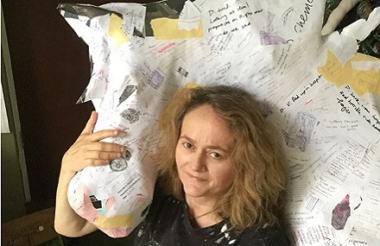Cathy Phelan-Watkins, the widow of Civil Society Media founder Daniel Phelan, has published a memoir of her time with her husband.
On a White Horse focuses on the seven week period during which Cathy constructed a life-sized horse out of memories of her husband, and charts the quarter of a century that they were together before Daniel died of bowel cancer, aged 58.
The book is available to purchase. Cathy’s work is also documented in a film, After Daniel.
Below is a review of the book from Diane Sim, one of Daniel’s friends and colleagues.
On a White Horse: an appreciation
As a long term contributor to Charity Finance magazine, I very much appreciated knowing Dan Phelan and feeling a valued part of the civil society publishing venture he set up in 1990. His premature death from bowel cancer in February 2015 was a shock and a huge loss.
Three years on, Civil Society Media, owned and managed by his widow Cathy Phelan-Watkins, is thriving. It has moved with the times – as any 21st century publishing house has to – but still embodies the values instilled by Dan: speaking truth to power in its reporting and showcasing the best at its events.
Like Dan, it is at once progressive and traditional. For those of us fortunate enough to have known him, Civil Society Media is still very much a monument to Dan.
Cathy Phelan-Watkins has also created another much more personal monument to Dan, which is documented in her recently published memoir: On a White Horse. It focuses on the period leading up to Dan’s death, when Cathy is managing his care, and the devastation of its aftermath, when Cathy is picking up the pieces and trying to make sense of it all.
And that is quite literally what she is doing. A graduate of Goldsmith’s Art College in the mid-1980s, she has turned to art to help her cope with what is clearly an overwhelming experience.
She has decided to create a monument to Dan: a life-sized, white horse worthy of Prince Charming, covered with ephemera documenting the last year of their life together: prescriptions, medical notes, shopping lists, doodles, Valentine cards, a marriage proposal and tributes from family, friends and peers.
As the horse takes shape, memories of Dan come thick and fast. He is almost conjured back to life, but not quite. Cathy’s horse, which has a beautiful, timeless, almost mythical presence, evokes a powerful sense of absence and loss. It is Prince Charming’s horse, but without Prince Charming.
As in John Keats’s Ode to a Grecian Urn, we try to buy into the poet’s admiration of the still, cold, timeless beauty of the urn but we – like the poet – are constantly distracted by the warm, passionate, all-too-human scenes depicted on it, which remind us of exactly what it isn’t.
Cathy’s horse, like her memoir, is simultaneously a celebration of the life she has shared with Dan and a monument to what she has lost. It is a courageous attempt not to dodge the pain of her experience but to distil it into something worthwhile – something that could help others understand and come to terms with the pain of loss.
It would be wrong to end this appreciation without touching on some of the threads woven into the main theme that make Cathy’s memoir such a powerful, affecting piece. They include:
- The love story of two young people – both at sea in different ways – who found that life was better together;
- The ‘Withnail and I’ depiction of a struggling artist making ends meet in bedsit London;
- The birth and burgeoning of the Young British Artists (YBA) movement, of which Cathy was a part, in the late 1980s and early 1990s;
- The pathos of caring for a patient who right to the end wants to make sure that everyone else is alright.
For people who knew Dan and recognise the impact he had and continues to have on the charity sector, this is a hugely rewarding read; for the recently bereaved and people caring for others with terminal illnesses, it should probably be available on prescription.









